#disabled characters
Explore tagged Tumblr posts
Text
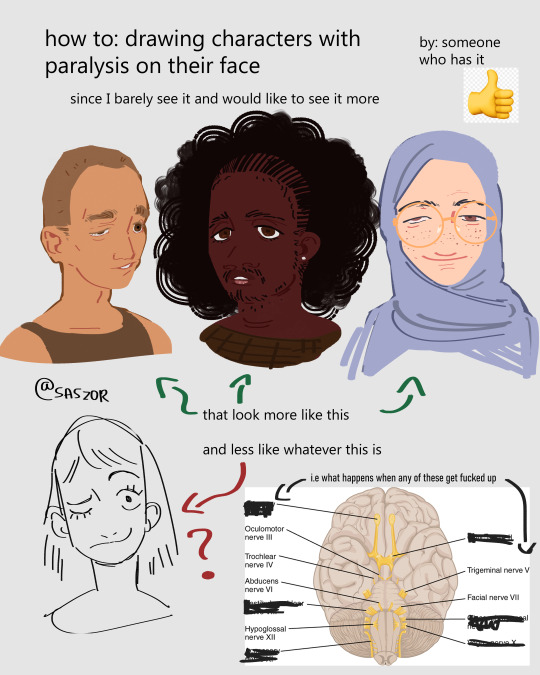


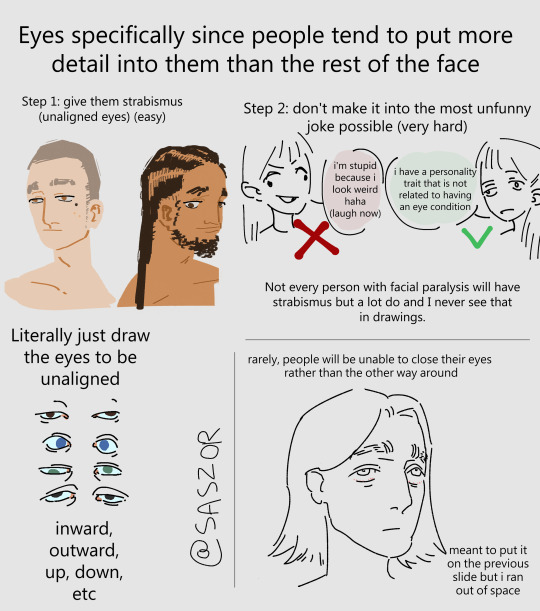
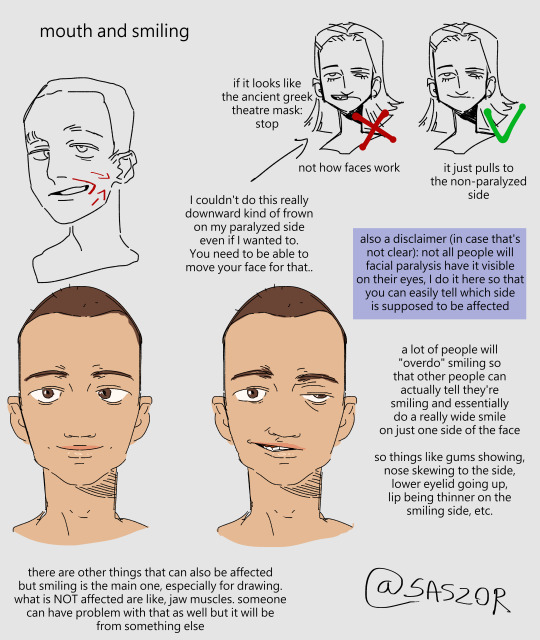
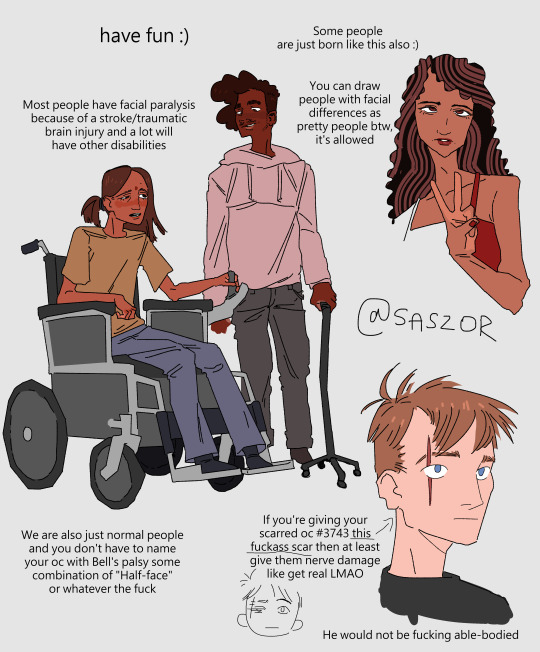
[ID in alt]
Tutorial on drawing characters/OCs who have some sort of facial paralysis. It doesn't cover all possible variants because I was using mirror as my main reference lawl
Keep in mind that this is an introductory drawing tutorial and has some generalizations in it, so not every “X is Z” statement will be true for Actual People 👍
Consider supporting me on ko-fi if you find this to be helpful.
#No 'omg mithrun dungeon meshi' notes that's not even what he has.#my art#artists on tumblr#disabled artist#digital art#id in alt text#art tutorial#drawing disabled characters#facial difference#disabled representation#disabled characters#digital artist#artwork#art on tumblr#art#body positive art#character art#disabled art#original art#personal art#illustration#drawing
23K notes
·
View notes
Text
Disability Tropes: The Perfect Prosthetic

[ID: A screenshot from the movie Nimona, showing Nimona, a small white girl with red hair, grabbing the right prosthetic arm of Ballister, a knight in black armour with black hair and light brown skin. He is holding a broken bottle in his prosthetic hand while Nimona admires his arm. Overlaid on the screenshot is white text that reads "Disability Tropes: The Perfect Prosthetic" /End ID]
In a lot of media, prosthetic limbs are portrayed as these devices that act as a near-perfect replacement for a character who has lost, or was born without a limb. So much so that in a lot of cases, the use of a prosthetic has basically no impact on the character beyond a superficial level or their appearance, or it's portrayed as something that's even better than the old meat-limb it's replacing. This trope shows up most often in Sci-fi, but it shows up in all kinds of stories outside of that, even otherwise very grounded ones!
If a story isn't depicting the loss of a limb as the be-all-end-all worst thing that can happen to a person, they almost always default to a perfect prosthetic, functionally curing the amputation with it. But the reality is that prosthetics are FAR from perfect, and as someone who has used them for their entire life I don't think they ever will be. Limb difference is still and always will be a disability, regardless of the prosthetics available, and this really isn't a bad thing.
Why is this trope so common?
I meant it when I said this is a really, really a common trope, so much so that the majority of the media I've seen with amputees and characters with limb differences that released in the last decade or end up using it. Even stories where becoming an amputee is treated like a fate worse than death, ironically, aren't excluded from this. I have a few theories as to why this has happened: The pessimistic answer is that it's easy. You get to have a disabled character and claim you have disability representation, without really having to do much extra work or research because most of your audience won't notice if you aren't accurate - in fact they kind of expect it. You also, for the most part, dodge the backlash other kinds of disability representation (or really any minority representation) usually get. The more optimistic reason is that, for a long time, amputees and people with limb differences (as well as a lot of other disabled people) were predominantly shown in media as sad, depressed and unable to do anything, very much falling into the "sad disabled person" trope. As a kid, this was really the only way I saw people like me on screen or in books. And so, the limb difference community pushed back against that portrayal and were pretty successful in changing the narrative in the public's eye. A little too successful. A lot of creatives were genuinely trying to do right by our community, listen and do better, but many simply overcorrected and instead ended up creating stories where prosthetics were essentially cures instead of the mobility aids they are. I also think the public's general lack of understanding about disability plays a roll in all this. There are a lot of people who, in my experience, believe that the more visible a disability is, the worse it is. Limb differences and amputations are very visible, but prosthetics, even those that aren't trying to be discreet, make them less so. While using a prosthetic is very, very different to a biological limb, you won't necessarily see how in a casual interaction with, say a co-worker or neighbor, especially because there is a very real stigma applied to people with limb differences to keep those things hidden from the public. There are other reasons too, such as the fact that a lot of creatives don't even consider the connection to real amputees when creating characters with robotic limbs in genres like sci-fi and some fantasy, so they never stop to consider that these tropes could be impacting real people. Amputees are also very frequently used in "inspiration porn" content that uses the angle that disabilities can be "overcome" with a good attitude, downplaying the way those disabilities actually impact us. The prosthetics industry - specifically the component manufacturers, often also push the idea of prosthetics being the only way to return to a "normal" life, both to the wider public and to people with limb differences and amputations (which can add to that sense of shame I mentioned when it doesn't play out that way for them). On top of that, I also think the recent increase in popularity of concepts like trans-humanism contributes to it as well. these movements often talk about robotic or bionic body parts being enhancements and "the way of the future", and I think people get a bit too caught up on what may be potentially possible in the future with the real, current experiences of people with "robotic limbs" aka prosthetics, now. There are also inherently disabling things that come with removing and replacing parts of your body, things that will not just go away with some fancier tech.
So How do you actually avoid the trope?
So, we have some ideas about why it happens, but how do you actually avoid the "perfect prosthetic" trope from appearing in your work? The most important thing is to remember that this is still a disability. The loss of a limb, even with the best prosthetic technology or magical item in the world, will always have some inherently disabling aspects to it - and this is not a bad thing. The key is to not over-do it, lest you risk falling into the old "sad disabled person" trope. So let's go over some of the ways you can show how your character's disability impacts them. You don't have to use all of these recommendations, just choose the ones that would best fit your character, their circumstances and your setting.
The prosthetic itself is just different
Probably the most important thing to address and acknowledge for prosthetic-using characters, is the actual ways in which the prosthetic itself is different from a biological limb, and the drawbacks and changes that come with that. For the sake of simplicity, I'm mainly going to focus on modern prosthetics here, but it's worth considering how to apply this your own, more advanced/fantastical prosthetics too. One major thing that most people writing amputees fail to acknowledge is that prosthetic limbs are not fleshy-limbs with a different coat of paint. They do the same basic thing their meat-counterparts do, but how they do it is often drastically different, which changes how they are used. A really good example of this is in prosthetic feet. There are dozens of joints in a biological foot, but most prosthetic feet have no joints or moving parts at all. Instead of having dozens of artificial joints to mimic the real bone structure of a foot, which are more prone to failure, require power and make the prosthetic much, much heavier for very little gain, prosthetic feet are often constructed from flexible carbon fiber sheets inside a flexible rubber foot-shaped shell. This allows the bend and flex those bones provide, without all the drawbacks that come from trying to directly mimic it. Making the sheets into different shapes makes them more ideal for different activities. E.g. feet made for general use, like walking around the city, are simple and light, shaped to encourage the most energy-efficient steps, while still allowing their users to do things like wear normal shoes. Feet made for rough terrain often have a split down the middle of the foot to allow the carbon fiber sheets to bend better over rocks when there is no ankle, and some newer designs also include a kind of suspension using pressurized air pulled from the prosthetic socket to allow some additional padding. Running feet have large "blades" made of these carbon fiber sheets to absorb more pressure when the foot hits the ground, and redirect the force that creates to propel their user forward as quickly as possible.

[ID: A photo of 4 prosthetic feet. On the left, the foot is covered with a black shoe, the one to it's right consists of a small, carbon fiber blade, split down the middle, in roughly the same shape and size as the previous foot. Next to the right is an even simpler and smaller carbon fiber foot with no split, and finally is a very short foot that is vaguely rectangular in shape. /End ID]
These are some of my own prosthetic feet I've had over the years. The two on the right are designed to be used by someone who is less mobile, and the ones on the left are made for someone who is more active. As my needs changed over the years, I've used different designs and styles, and keep the old ones since my needs do tend to fluctuate.
There are also robotic feet available that are designed as a kind of "all-purpose" foot that use an electronic ankle which more closely mimics a biological foot, but they are not very popular as the mechanism adds a lot of extra weight and it requires a battery and power to work, with many amputees feeling the jointless carbon fiber feet do a better job at meeting their needs. The same goes for arms and hands. "Robotic" hands that mimic a meat hand exist, but they aren't really that popular, even in places like Australia where the prohibitively expensive price tag isn't as much of an issue due to government programs that pay for the device for you. Instead, most arm amputees who use prosthetics that I know prefer simpler devices that do specific tasks, and just swap between them as needed, rather than something that tries to do it all. A big part of this is because the all-purpose hands can be clunky. they often require manual adjustment using the other hand to do simple things like going from holding a deck of cards to putting them down and picking up a glass of water, for example. The few that don't require that, I've been told, are often temperamental and don't actually work for every person with a limb difference.
Altered Proprioception
Loosing a limb is a big deal and this is always going to have an impact on the body in some way that won't be solved with a fancy piece of tech. One such example is how limb loss effects your sense of proprioception. This is your sense of where your body parts are in space. It's how you (mostly) know where your foot is going to land when you're walking, or how you're able to do things like lift up a glass of water without needing to actually watch your hand do it. Your brain does this by creating a mental map of your body, but this map doesn't get adjusted if you loose a limb. If that map doesn't accurately reflect your real body, you're not going to have an accurate sense of proprioception. This might look like a leg amputee being a bit less stable on their feet, or like an arm amputee needing to look at their arm or hand to be able to grab something with it. Those born without their limbs who take to using prosthetics often have a lot of trouble adapting, as their brains aren't used to having that limb in the first place, whereas an amputee's brain can sometimes be tricked into using their outdated body map to help them adjust to the prosthetic (though its impossible to line it up perfectly). Prosthetics that directly integrate with the nervous system, while rare, do exist, and even this direct connection doesn't completely erase this issue for reasons doctors aren't quite sure about. This is something that does become less of a problem with time. Eventually, someone proficient with their prosthetic will learn to compensate, but their sense of proprioception will never be 100% perfect. At the end of the day, no matter how it attaches, a prosthetic is still not a natural part of the body, and that will always cause some issues. It also means if they aren't practicing it all the time, they may have to relearn how to compensate for it.
Extra weight
You also have to remember that a prosthetic is not a natural part of the body, like we already talked about, and so no matter how good it is, your brain will most likely always interpret the weight of the prosthetic as something attached to you, not part of you. This means that, even though prosthetics are actually a lot lighter than biological limbs, they feel so much heavier. This is because, while a meat limb is heavier, a lot of that weight is from muscles which are actively contributing to the limb working, so it doesn't really feel like its that heavy. When you have less of your meat-limb though, you have even less muscle to work with to move this big thing strapped to it, so it feels heavier. The more of the limb you've lost, or just didn't have, the heavier the prosthetic has to be, and the less muscle you have left to move it. It's for this reason that a lot of amputees and people with limb differences get tired faster when using prosthetics. Some of us are fit enough where you almost wouldn't notice the extra effort they need to put in, but once again, just because you can't see it from the outside, doesn't mean it's not an issue.
Avoiding Water
Most prosthetics also aren't waterproof, and so prosthetic users have to be very careful about when and how they come into contact with it. For amputees with electric components, contact with water at all will likely damage the device. This can even include especially heavy rain, something I was told to avoid when I got my electronic knee prosthetic and something I assume would also apply to arm amputees with complex, electronic hands. For those with non-electronic prosthetics, water can be hazardous for different reasons. If the prosthetic has metal components, water may cause them to rust, especially if it's salty water. Other prosthetics have foam covers to give the illusion of a limb with the general shape of muscles and fat, but these covers do not come off, and if they get wet enough that water seeps all the way through, it is very hard to dry it and they may become moldy. Finally, cheaper modern prosthetics may also float. Many are made of very light-weight materials and some have pockets of air trapped inside them. For leg prosthetics in particular, this means a user might, at best, struggle to swim with them on, but at worst, may get flipped upside down and become trapped underwater - something that happened to me as a very young child. On the flip-side, older prosthetics were usually made of heavy materials like wood or steel, and so had the opposite problem, acting like a weight and pulling a person down if they were to wear them in the water. Water-safe prosthetics do exist, I had a pair of prosthetic legs as a teenager that were hollow, and designed especially for me to swim with fins on when swimming in the ocean, and Nadya Vessey, a double leg amputee in New Zealand even got a mermaid-tail prosthetic made especially for use in the water. Most amputees though just swim without any prosthetics at all, and in 99% of cases, this is the easiest and safest way to go.
Prosthetic-Related Pressure Sores and Pain
Many people with limb differences also experience pressure sores from their prosthetics. Modern prosthetics typically attach to the body using a socket made of carbon fiber or fiberglass, held on either by pressure, using a vacuum seal or through a mechanical locking system built into the socket. No matter the specifics though, the socket has to be very tight in order to stay on, and this means that extended periods of use can lead to rub-spots, blisters and pressure sores. Many socket prosthetics also use silicone liners to add extra padding, but this means wounds caused by the pressure can't breathe, and bacteria in sweat has nowhere to go, meaning if the person doesn't rest when one of these wounds occur, it can very easily and quickly turn into a serious infection. In a properly fitting prosthetic, used by someone who has fully adjusted to them, this doesn't happen often, but it is something most amputees and people with limb differences have to at least be mindful of. Some new prosthetics use a different method of attachment, called Osteointegration - where the prosthetic attaches to a clip, surgically implanted into the person's bones. While Osteointegration avoids many of the issues like pressure sores that come from a socket, they have their own issues: mainly that they are incredibly expensive, and as of right now, have a pretty high failure rate due to the implant getting infected. Because the implants are directly connected to the bone, these infections become very serious very quickly. Many people with Osteointegration limbs have to be on very strong medication to keep these infections at bay, and they are generally considered unsuitable for anyone who is going to regularly come into contact with "unclean" environments.
Maintenance

[ID: A screenshot of Winrey, from Full Metal alchemist Brotherhood, a white woman with blond hair handing out the sides of a green hat. She is measuring a piece of metal from a prosthetic she is making while Ed, the prosthetic's owner, gives her a thumbs up in the background. /End ID]
Finally, prosthetics also require maintenance from a specialist called a prosthetist, and they don't last forever. Some parts, like a foot or hand, can be reused over an over, but the sockets of a prosthetic need to be completely remade any time your body changes shape, including if you gain/loose weight, you start experiencing swelling, or you're just a child who is growing. Children in particular need new prosthetics every few months because they grow so fast, and as such, their prosthetics have to be made with this growth in mind. If they go too long without adjustment or an entirely new prosthetic, it can seriously impact the child and their growth but even small adjustments can be costly, depending on where you live. While prosthetics are built to be sturdy and reliable, they need a lot of work to stay that way. The more complex the prosthetic, the more work is needed. Complicated electronic components may need to have regular maintenance done by your prosthetist or even the specific component's manufacturer, and depending on where you live, this might mean having to send your prosthetic limb away for this to be done. While my prosthetist technically has the skills and knowledge to do the maintenance on my electronic knee, for example, the manufacturer forbids anyone not from their company to provide this service, meaning my leg needs to be shipped off to Germany once every few years if I want to keep the warranty. This has the unfortunate side effect of sometimes your limbs getting lost in postage (shout-out to Australia Post, who lost mine twice), meaning it can be months before you get it back or get a replacement. Usually, you'll be given a replacement in the meantime if you need it, but walking on a leg that isn't yours, even when its correctly fitted, always feels a bit weird (maybe that's just me though).
Not every difference is Inherently Negative
We've talked about some of the negatives that come from having a prosthetic, but not every difference is negative or even really that big of a deal. In fact, often times, it's these little moments in the depiction of a disability that go the furthest and make it feel the most genuine. My amputations effect me from the moment I wake up, to the moment I go to bed, but that doesn't mean every single way it impacts me is always inherently bad or negative. For example, back when I was working a normal job and going to university, I would often come home, throw my legs off at the door with the shoes still attached and get into my wheelchair, the same way you might throw your shoes off after work and replace them with comfy socks and other comfy clothing. This is something I've only ever seen on screen once, with Eda from the Owl House (and she wasn't even an amputee yet, her limbs were just detachable)

[ID: an screenshot of Eda from the owl house, a very pale woman, laying on the couch in a bathrobe, her hair in a towel. She has taken her actual legs off, throwing them to the other side of the seat. /End ID]
After that, my day mostly looked the same as most other people working a 9 to 5, I'd make myself dinner, watch some TV or play some games, maybe do some extra work at my desk or chat with friends. The only difference is that it would all be from a wheelchair, mainly because my prosthetics were heavy and it was just easier to use the chair around the house. The fact my afternoon and evening routine was done from a wheelchair wasn't a bad thing, it was just different. Likewise, I also don't sleep or shower with my prosthetics on, for the same reasons most other people wouldn't take a shower or sleep in thigh-high, steel-capped boots. In your own stories, this might look like giving your characters similar alterations to how they go about their day. Let them take their arm or leg off when they're resting or relaxing, show them taking a few minutes longer to get ready because they have to put it back on, show them doing some things without it. Arm amputees in particular tend to get very good at going about their days without their arm prosthetics, and leg amputees often either learn to get around more relaxed spaces like their homes using a different mobility aids like wheelchairs or crutches, or just through hopping if that's something they're physically able to do. Even when everything is going well and working as intended, your limb-different character won't wear their prosthetic 24/7, no matter how much they love it. There doesn't have to be something wrong with it or painful about it to not want it glued to them at all times, just like you can love a pair of big heavy boots but not want them on when you're trying to sleep. For more action-focused stories, being an amputee, also changes things like how you fight. The specifics will vary from person to person, but for example, when I did Hap Ki Do, a Korean Martial art, my instructor heavily modified when I learned what techniques. Beginner-level kicks and most leg attacks were impractical for me, as the force from the kicking motion would usually cause one of my legs to fly off. I also couldn't jump very well, due to some complications with my original amputation that made my stumps too sensitive to withstand the force of landing again. So I ended up learning a lot more upper-body attacks much earlier than it is typically taught. By the time I got my green belt, I was practicing upper-body techniques usually saved for black belts - including weapons training that I could use my secondary mobility aids for, like crutches and my cane in a bad situation. Many holds that rely on creating tension in your target are also less effective on amputees, because either the anatomy that causes those holds to be painful just simply isn't there, or the body part in question can just be removed to escape. Whether we're talking about the negative things, or just neutral differences that come with using prosthetics, you don't want to go too far with any one example. The key is to strike a balance. Of course, the old writing advice of "show don't tell" also applies here. It's one thing to tell us all of this stuff, but unless we actually see it play out, it won't mean much.
How NOT to avoid the trope
Before we move on, let's focus for a moment on some common things I've seen that you SHOULDN'T do as a way to get away from the trope.
The Enhanced Prosthetic
A lot of sci-fi in particular will take prosthetic limbs, make them function exactly the same as a biological limb, but add something extra to it. This does change the way the prosthetic functions and is used, but it usually still ignores the actual disabling parts of having a prosthetic. A really good example of this can be seen in pretty much any futuristic setting, but personally, I think Fizzeroli, from Helluva Boss is the best one to demonstrate what I mean. Fizz is a quadrilateral, above knee/above elbow amputee with highly advanced prosthetics that function, more or less exactly like the limbs he lost, but with the added benefit of being super-stretchy. Fizz is an acrobat and a clown in service, at least initially, to Mammon, one of the Seven Deadly Sins. These prosthetics help him perform and we even do see how they change little things like how he walks and just goes about his day, but the show still treats them like natural arms and legs, but better.

[ID: A screenshot of Fizzeroli from Helluva Boss, a white-skinned imp with 4 black, prosthetic limbs, dressed in teal a nightgown as he lays in bed, reading from a list /End ID]
We see that he never takes them off, even when sleeping, and when he needs to use them as regular arms and legs, they do everything he needs, perfectly fine - at least when they're working correctly. The only time he ever even takes them off or has any issues with them, is when they break in season 2. The word amputee is never used to describe him, as far as I remember, and the fact he is one never really comes up at all, except for when they break or when the story focuses on how he lost them. Which brings me to my next point.
The Glitchy/Broken Prosthetic
One way I see people try to avoid the perfect prosthetic trope, is to take the prosthetic and break it or otherwise make it unreliable by having it malfunction, but not really changing anything else. This approach is heading in the right direction but still kind of misses the point of the criticism a lot of limb different folks have with the depictions of prosthetics in the media. Yeah, prosthetics do break down and some do require extra maintenance, but if your character's prosthetic is still exactly the same as a biological limb (or even better, in the case of the "enhanced prosthetic") when it's not broken, and the only time their disability is treated like a disability, is when it breaks, you're not really addressing the issue. Real prosthetics, like we discussed, even when functioning at 100%, exactly as the manufacturer intended, don't function the same as a meat-limb. They are fundamentally different, and the glitchy/unreliable prosthetic completely ignores all of that. Once again, Fizz is a really good example of this - the only time his prosthetics are not perfect, is when they break or are malfunctioning (despite the criticism, I do genuinely love Fizz as a character, but he unfortunately does fall into a lot of disability tropes).

[ID: Another screenshot of Fizzeroli, this time in a torn up jester outfit, looking down, panicked, at his prosthetic arms which are fully extended and laying motionless on the ground, with his left arm visibly short-circuiting with electricity around it. /End ID]
Now this isn't to say you can't have your character's prosthetics break down or malfunction at all. just that this shouldn't be the only way you differentiate the prosthetic from a biological limb. You should also be mindful of how or why they're breaking. A typical prosthetic isn't going to break down randomly from normal use unless something is very, very wrong or your character just has a terrible prosthetist (which unfortunately, does happen). You might experience issues if you try to make the prosthetic do something it just wasn't designed to do, or expose it to something it wasn't designed to deal with though (e.g. submerging an electronic prosthetic in water and trying to use it to swim).
Just add Phantom Pain
Another common pitfall I see when people are trying to avoid the perfect prosthetic trope, is to just give the character in question phantom pain - which is a side-effect of amputation where your brain's mental map of the body doesn't acknowledged you lost a limb. Your brain tries to fill in the gaps, since there is no signals coming from that part of the body anymore, and assumes either something must be wrong and so you should be in pain, even when you actually aren't. Alternatively, it can also happen when your brain was so used to feeling pain from that area before, in the case of people who had chronic conditions before they lost their limb, that it just keeps remaking those old signals itself. Like the broken/glitchy prosthetic approach, this also doesn't really address the issue with the perfect prosthetic trope, because it has nothing to do with the prosthetic itself. Phantom pain doesn't come from the prosthetic, nor does it effect how they're used, and so including it doesn't really address the issue of the prosthetic being functionally the same as the original, biological limb. This isn't to say that you shouldn't include phantom limb sensation or pain as something your character experiences, but just keep in mind that, when used on it's own, it doesn't counter the trope. Also, just be sure to do your research, everyone's experience with phantom pain is different and it's not something everyone with a limb difference even experiences.
Why is this trope even a problem?
Alright, so we know what the trope is, we know why it became so prevalent, ways to avoid it and also how not to avoid it. All good information, but why is this trope even bad? Why should you try to avoid it? Outside of just wanting to portray a real disability that effects real people more accurately in your creations, the prevalence of this trope actually contributes to a lot of real-world issues, especially when it's as overused as it currently is. I've talked before about "the jaws effect" - where the depiction of something in the media, especially something that the public is widely uneducated on, influences how people see it in real life. The Jaws effect specifically referred to how the popularity of creature-feature movies featuring sharks, like Jaws, caused the belief that sharks were monstrous killing machines to become much more wide-spread, even going so far as to influence decisions about laws and policy surrounding real-life shark preservation and culling in some parts of the world. But sharks aren't the only thing this has happened to.
Disabled people are so thoroughly misunderstood by wider society, that when tropes like this one become popular, people can and often do start to believe the misinformation they spread - in this case, believing that our prosthetics are a perfect replacement for a biological limb, and that getting a prosthetic means you're not disabled any more. While this can be annoying and cause small scale issues for some of us, like people giving us a hard time for using disability accommodations we very much need, it can also impact us in systemic ways too. If the wrong people believe these tropes, it can and does have a very real impact on the lives of disabled people through things like changes to policies to make it harder for amputees and people with limb differences to access financial assistance for other things outside of our prosthetics we may need assistance with.
Conclusion
Despite the very real harm tropes like this can do when it's overused, I don't think it should go away entirely. Some of my favourite pieces of media even use the perfect prosthetic trope and there are even some kinds of media where I even think it's somewhat unavoidable. Characters with perfect prosthetics in kids media in particular, especially when talking about side characters, can help to correct some of the other stereotypes kids may have seen elsewhere - such as prosthetics being "creepy" or "scary" - in a way that is casual and easy for them to understand. The problem with the trope, in my eyes, is it's excessive overuse. It's the fact that it seems to be the only representation amputees and people with limb differences are getting now. Not every story with a limb-different character can or even should delve into the reality of what using prosthetics is actually like, but we need at least some stories that do, without it being this majorly depressing thing.
#Writing disability with Cy Cyborg#Disability tropes#Long Post#Disability Representation#Writing Disability#Writing#Writeblr#Authors#Creators#Writing Advice#Disabled Characters#On Writing#Disability in Media
3K notes
·
View notes
Text


felt off today, so drew some shit posty drawtectives reactions
#digital art#disabled characters#drawtectives s3#drawtectives fanart#drawtectives grandma#drawfee drawtectives#drawtectives#drawfee fanart#drawfee#eugene finch#grendan highforge#drawtectives grendan#york rogdul#jancy true#rose drawtectives
886 notes
·
View notes
Text
being unattractive or physically different/disabled DOES NOT equal being morally bad/evil. there is an atrocious amount of ableism that occurs when someone doesn’t look “normal.” and i am so fucking sick of it.
in media it is (almost) always the villains who are different/disabled. and media is a massive part of how people form their world views.
i want to mention arcane for example, because people seem to be confused about what good representation is. people praise the hell out of that show, and for good reason it has great things about it, but people told me it had good disabled representation. so i watched it. and while parts of the disabled representation is good.. almost all physically different/disabled characters are portrayed as bad/evil/villains at some point in their story (or all of it.) and then by the end of the show most of them are dead.
abled people i need you to understand that is not good representation. please look out for these tropes it happens ALL the time.
good representation includes different/disabled characters who are heroes and morally “good” too.
if you make all your villains physically different and none of them are heroes i hate you. i am so sick of this.
#chronic illness#chronically ill#disability#chronic pain#chronic fatigue#disabled#physical disability#physically disabled#physical deformity#physically deformed#visibly disabled#disabled characters#disabled representation#arcane#disabled media#disabilties#disability advocacy#vent post#rant post#🍯.chrncsick
973 notes
·
View notes
Text
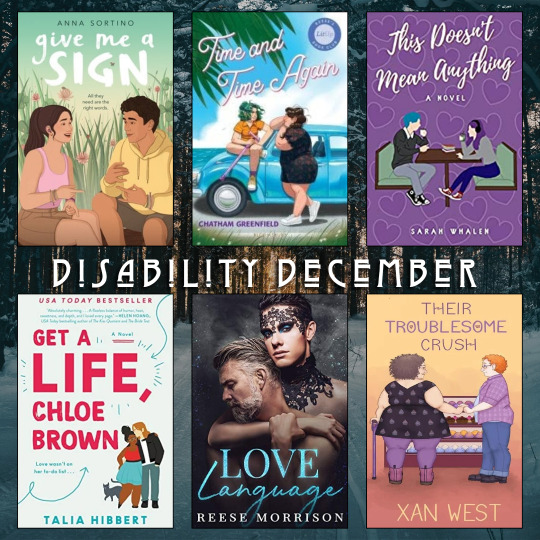






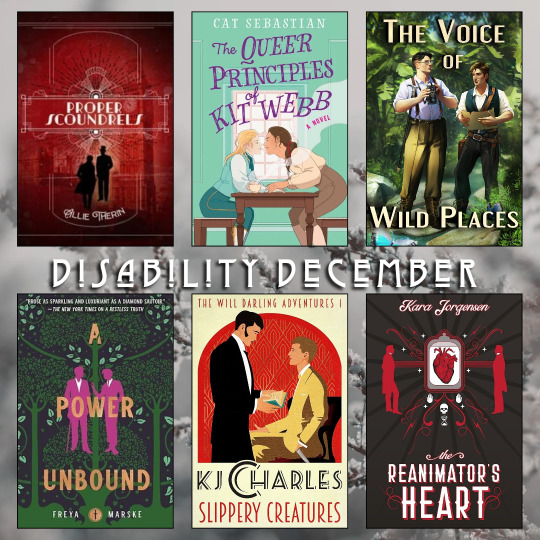

December is Disability Awareness Month, and so here are some great books with disabled leads. There's contemporary, fantasy, graphic novels, and two pages for historicals because we all know I can't restrain myself when it comes to them.
#noahs book recs#queer books#indie books#book recommendations#book recs#lgbtqia books#disability awareness#disability pride#disabled characters
845 notes
·
View notes
Text
SPOILERS FOR CH 85 OF WIND AND TRUTH
.
.
.
.
.
.
.
.
.

Had an idea for modern au Adolin and Maya
(please no spoilers for the book, I'm still on day 7)
#stormlight archive#wat spoilers#wind and truth spoilers#artists on tumblr#stormlight fanart#cosmere#my art#adolin#wind and truth#adolin kholin#mayalaran#cosmere fanart#disabled characters
733 notes
·
View notes
Text
PSA for artists during disability pride month
CRIPPLE YOUR ART
From experience: Sleeping with a prosthetic limb on is like sleeping with a backpack still strapped to you after a long day of school ok yall gotta stopppppp making art where characters are wearing a prosthetic to chill or nap or have sexy time come onnnn now
Yes yes i acknowledge nuances and suspension of disbelief and magic and exceptions blah blah blah but the point of this post is that as a limb different bitch IM TELLING YOU yall gotta get past the aesthetic of able bodiedness and get comfy w understanding and representing disabled bodies in their natural state bc it's limiting your art and yall don't even know it. Cripple your art, you cowards!!!
(This is a desperate plea from a one-armed Trigun 98 fan art enjoyer)
6K notes
·
View notes
Text
LGBTQ Disabled Characters Showdown Quarterfinals Poll 1


Vs.
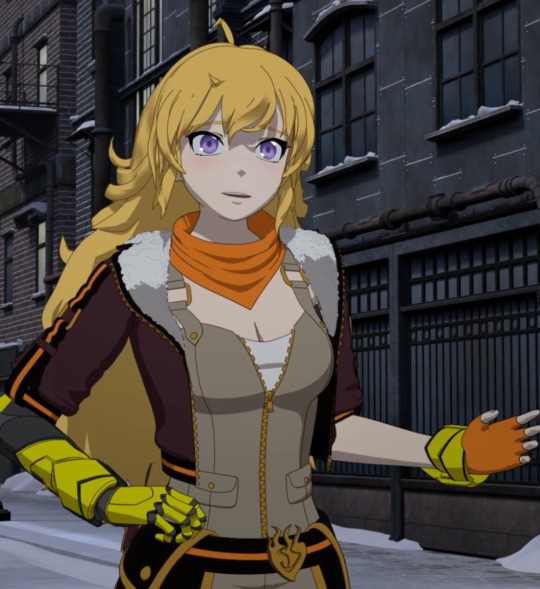
Please be civil in the notes. We will block people if we feel it is necessary. A character being canon LGBTQ+ and disabled was not required to be in this competition. Please check qualifications and propaganda before asking why a character is included. This is not a competition of who is better representation.
Check out the other polls in the quarterfinals here.
Edit: This is a two vs. one because they tied (by our defenition) back in round 4 and moved on together.
Harrier ‘Harry’ du Bois-Disco Elysium
Qualifications:
Bisexual. Struggles with addiction, post-polio syndrome, multiple kinds of mental illness, and whatever else he's accrued by living in a city with no accessible healthcare.
Propaganda:
You know who he is. Vote for him.
Kim Kitsuragi-Disco Elysium
Qualifications:
Visually impaired
Propaganda:
I dunno man. He's Kim Kitsuragi. There's nothing I can say about him that hasn't already been said. He's quiet and reserved and uncomfortable with emotions. He's a self-proclaimed Torque Dork who loves his car like a child. He listens to heavy metal music. He's a centrist. He's a homosexual. He's consistently given shit by everyone around him for his race, his sexuality, and his disability, and he's taught himself to respond to it with cold professionalism. He dresses in historical communist pilot cosplay. I love him with my entire heart.
Yang Xiao Long-RWBY
Qualifications:
She is canonically wlw (has been for years but specifically kissed and got together with her now girlfriend in the latest season) and uses a prosthetic arm and has been shown to struggle with PTSD due to the traumatic nature of losing it during the show.
Canonically had her right arm chopped off, uses a prosthetic. Has PTSD. Is canonically in a WLW relationship.
She has a canon girlfriend and canonically has a prosthetic arm and PTSD
She's canonically sapphic (part of a recently canonised wlw slowburn relationship) and is an amputee (due to events from the 3rd season finale) who wears a robotic prosthetic. She also suffers from PTSD which is explored in the show
Propaganda:
I will keep on submitting Yang to relevant brackets until I die. RWBY has plenty of strengths and weaknesses with writing, especially Yang's recovery arc, but instead of forcing her to push past her trauma and enter the battlefield immediately, we see her struggle with it, take time to process, and not be pushed into repression and when she chooses to wear her prosthetic, chooses to train to ready herself, and chooses to seek out her family and save lives, she isn't perfectly healed, as no one is. The show depicts her having flashbacks due to sudden loud noise, shaking hand the first few times she has to fight for her safety instead of training with her dad, and snapping at friends when they bring up Blake, the person she lost her arm trying to save (who, near immediately after ran away due to feeling she was endangering those she loved, furthering Yang's already present abandonment issues.) It isn't done perfectly but the intentions and general message sent are extremely positive and honest. She struggles less as the show progresses, and there are opportunities to consider herself less for being disabled or "become whole again" but she explicitly refutes these ideas and says that's she's better because of her failures and losses, and isn't any less whole. Her becoming disabled is also extremely tied to her being LGBT, because, as previously mentioned, she lost her arm protecting her then friend and partner, now girlfriend, directly after the villain who cut her arm off told her love interest that he would "destroy everything [she] love[s]. (Camera pans to Yang, he looks at her.) Starting with her." LIKE. He attacked her BECAUSE Blake cared for her so much and Yang ran to her defense blindly BECAUSE she loved Blake so much. When they reunite, they struggle with communication because Yang feels Blake is seeing her as weak, and through several things, mostly a climatic battle against the man who severed Yang's arm, they affirm each other as equals. I can go on but this is already too long. YANG SWEEP!!!!!
Yang lost her arm while protecting her best friend and future girlfriend from said girlfriend's abusive ex. Had a whole arc about learning to live with that loss and dealing with PTSD. Is totally devoted to and in love with Blake Belladonna and is just the sweetest but most badass character in the show.
She's one of the main characters, and just finished a 10 year slow burn romance. Plus, she has both physical and mental disabilities, but is never treated as lesser or incomplete.
Yang Xiao Long was one of the first examples of a sapphic character I ever saw in animated media with her character journey in the show being an iconic part of my teenage years and current young adulthood. The loss of her arm after a traumatic event in the show's 3rd volume was one of the big shockers of the show that nobody saw coming. Since then the show has done an amazing job in exploring both the mental and physical effects of her losing a limb, gaining a prosthetic arm and the recovery journey. Her character also has a major arc regarding handling her PTSD from both this and her past most notably in the 5th and 6th volume. Her character also has a slow-burn romance with her teammate and fellow main character Blake Belladonna which is one of my fave romances ever (it has everything: canon soulmates, friends to lovers, sunshine x grump,battle couple etc..) that has recently became CANON BABIEE!!! There are MULTIPLE characters in RWBY with various disabilities that are handled well in the narrative but i would say Yangs definitely the top FAVE!
#polls#poll#disability#disabled characters#lgbtq#lgbtq characters#id in alt text#lgbtq dcs quarterfinals#harry du bois#harrier du bois#kim kitsuragi#disco elysium#yang xiao long#rwby
591 notes
·
View notes
Text
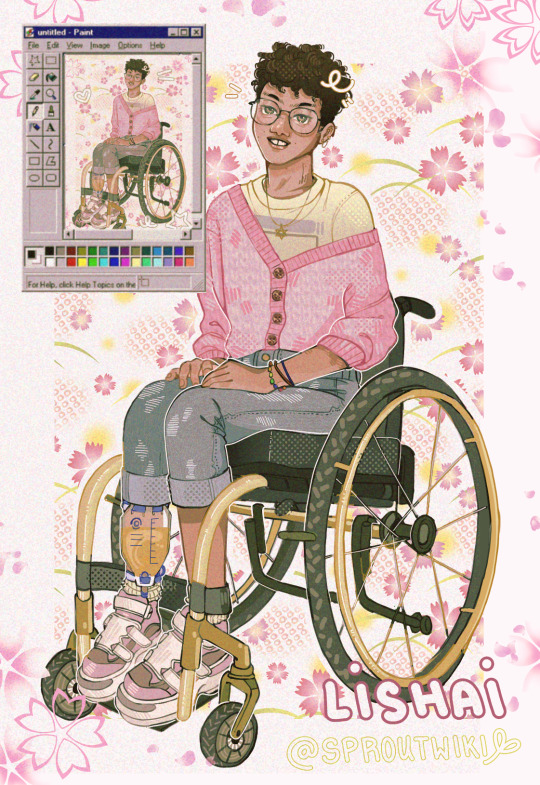
Lishai 🌈🌸♿️🩷🪴 [ID in alt-text]
He has PPMS and uses an intermittent catheter! There is way too much stigma (from both disabled and non-disabled people) about incontinence, catheters, and bladder issues. It’s not “gross”. The only “gross” thing is being judgmental of disabled people for something they cannot control and keeps them alive.
#my art#art#original characters#disabled artist#disabled characters#disabled oc#wheelchair user#catheter#ms#multiple sclerosis#illust#illustration#babe with a mobility aid#disabled and cute#wheelchair
4K notes
·
View notes
Text


I often get the question, “How do you write women?” or “How do you write a dwarf?” Some of that can be resolved by research or talking to people. I had a correspondence with a fan when I was writing the first and second books, long ago, who was a paraplegic, paralyzed from the waist down, and he gave me a lot of valuable insight about how to write Bran and what it would be like. That kind of information from other people, you can never duplicate.
- George R.R. Martin, Ideas At The House (2013)
There are things we all go through, but there are experiences that I haven't had, and when I'm writing about one of those, I try to talk to people who have had that experience. When I first had Bran crippled by his fall from the tower, I had one fan who was paraplegic, and he and I exchanged a number of emails about what it was like to be paraplegic because I could try to imagine that, but I don't actually know it. When I wrote the scene where Sansa has her first period, I talked to a number of women and asked, “What was it like to have your first period? Was it scary? Was it nothing? Was it painful? Tell me about it!” I got about 16 different stories that varied very widely. People who have actually been in combat, I talk to before the combat scenes, and that too varies widely. That's sort of interesting, and, of course, I've read a lot about that. There are some experiences that only women have had in our society, and when I tackle them, I try to consult with women.
- George R.R. Martin, NIFFF Masterclass (2014)
You do have to research the things that can be researched, and sometimes that involves books; sometimes it actually involves talking to people. Those are the trickiest things, if it's a human experience. I'll give you a couple of examples from Game of Thrones. When Bran gets thrown out the window and paralyzed. I'm not paralyzed, I don't have any close friends who are paralyzed, but I wanted to try to get that as accurate as I could, so I did a fair amount of reading about that. I also had a couple of fans who corresponded with me through email about the problems of someone who was paralyzed from the waist down and what it would be like. I also have a scene where Sansa, who is engaged to Joffrey but hasn't flowered yet—hasn't had her first period—so she can't be married by the traditions of Westeros, then has it and is eligible, by medieval standards as well as the standards of Westeros, to be bedded and wedded and bred. Of course, she reacts to that with considerable panic. But I also wanted to know what it is like, and that led to a number of embarrassing conversations with women I knew about: “When did you have your first period? What was it like? Was it painful? Tell me about it!” What I discovered was a wide variety of different stories. It's not always the same thing, so I had to try to make sense of that and do something that had authentic truth to it. Hopefully, I did, but human experience is variable. No matter how much you research, there will be somebody out there who had a different experience, and then they'll write you an annoyed email saying, “You got that all wrong. You don't know anything about that.” Well… okay. But I tried.
- George R.R. Martin, Author Event Series: Featuring Marlon James (2019)
#Bran Stark#Sansa Stark#Disabled Characters#Female Characters#Scenes#George R.R. Martin#ValyrianScrolls#ASOIAF
492 notes
·
View notes
Text





2024 in BL was the year of disabled representation (not always good but it was there) and the year of curing blindness and the year of learning sign language and honestly it was impressive to see this many in one year, may it continue and get better year by year. @absolutebl MY favorite trend of last year.
We did also have two character with anxiety disorders that everyone took seriously including the show!


#bl 2024#disabled characters#blind characters#deaf characters#thai bl#chinese bl#taiwanese bl#thai gl#gl series#bl drama#thai drama#asian lgbtq dramas#asianlgbtqdramas#thai series#thai bl series#thai bl drama#thaibl#bl series#gl drama#pluto the series#last twilight the series#see your love#blue canvas of youthful days#2024 was the year of the disabled BL character#and i saw nothing this year#so maybe we only get one year#i could cry because we deserved more#first note of love#taiwanese bl drama#kidnap the series
324 notes
·
View notes
Text
Happy Face Equality Week :-D

(short ID in alt text, longer below)
I really wanted to draw some happy people with facial differences for this week so:)
if you tag this as "tw scars" or some other "body horror" I'm killing u btw:D!!!
[Image description: digital drawing of 7 character with facial differences against a patterned background. The left side shows a gay couple sitting and hugging; one from them has a large bump on his forehead and widespread eyes, while the other has paralysis on one side of his face. In the middle is a teen girl cuddling with a cat, both of which are missing their left eye. Below her is a nonbinary person smoking a cigarette with heart-shaped smoke surrounding them; they have facial atrophy on one side of their face. The right side is split into three small panels; top one shows a Black girl with a cystic hygroma on her jaw on a pastel pink background, middle shows an Indian man with Crouzon syndrome from the side smiling, bottom is a zoom on the side of the head of a person with microtia; they're wearing a bone-anchored hearing aid and have a buzz cut with stars patterned in it. At the bottom, "Happy Face Equality Week" is written. End image description.]
#my art#disabled artist#artists on tumblr#digital art#disabled ocs#personal art#art#queer artist#described art#facial difference#face equality week#face equality#disabled art#disability positivity#disability pride#disabled characters#disability representation#digital artist#body positive art#small artist#original art#illustration
3K notes
·
View notes
Text
Forgetting your character is disabled isn't a "good representation" flex: Writing Disability Quick Tips
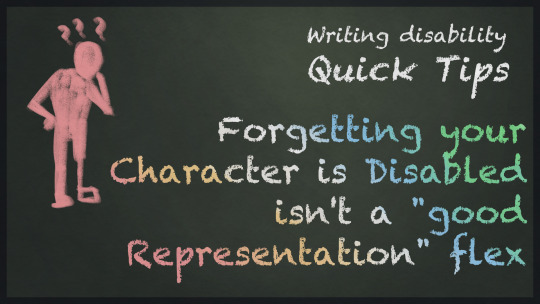
[ID: An image with “Writing Disability quick tips: Forgetting your character is disabled isn't a good representation flex” written in chalk the colour of the disability pride flag, from left to right, red, yellow, white, blue and green. Beside the text is a poorly drawn man in red chalk looking down confused at his leg, one is drawn normally, the other is drawn to resemble a basic prosthetic. He has question marks above his head. /End ID]
For a while, I was involved in the booktok and Tik Tok writing communities, specifically parts of the community focused on more diverse books and authors. During this time, I noticed a reoccurring pattern when people were highlighting stories featuring disabled characters, or even promoting their own books, and that was how often people would say "I kind of forget they have [insert disability here] because they're such a badass."
The intention behind this statement is (usually) good, with people trying to show that their disabled characters are self-sufficient and don't fall into the tired old sad/helpless disabled person trope, however, you can - and very much should - do that without erasing your character's disability. If you find yourself forgetting your character is disabled, or your beta and pre-release readers are commenting about forgetting it, then there's a good chance that's exactly what you've done - and as a disabled person myself, if I see that statement being used in your marketing in particular, it's a giant red flag and a sure fire way to make sure I give the book in question a skip.
Remember, disabilities (especially major ones) are a part of your character's identity, and they're important regardless of the character's personal relationship with it. Even if your character doesn't specifically identify with the label of disabled or doesn't really care that much, it's should still be impacting their daily life, even in small ways. If you're finding yourself forgetting about a major part of your character's identity, it might be a good idea to check and make sure their disability is having an impact on the character.
I see this comment most often with amputee characters, and to me, it's a pretty consistently good indication that the author has treated their character's prosthetic as a cure rather than the mobility aid it is. It's far from unique to amputees, mind you (I talked about this a lot when I was discussing the character of Toph from Avatar), but it's when I tend to see it the most. Remember that mobility aids and other forms of assistive technology and assistive magic (if it's a fantasy story) are just that: they're aids, they assist, they shouldn't be cures.
Of course, this wasn't unique to Booktok, I've seen it on nearly every other social media site with a writing and book-focused community at some point, but Tik Tok was just where I spent the most time and it seems to be where I see the most people specifically gloating about it.
#Writing disability with Cy Cyborg#Quick tips#Disability#Disabled#Disability Representation#Writing Disability#Writing#Writeblr#Authors#Creators#Writing Advice#Disabled Characters#On Writing#book marketing
1K notes
·
View notes
Text

Earth and eclipses hangout doodle :3333
#tsams eclipse#sams eclipse#the eclipse and puppet show#eaps eclipse#teaps eclipse#the lunar and earth show#lunar and earth show#laes earth#earth laes#tsams earth#wheelchair#crutches#disabled characters
264 notes
·
View notes
Text
Disabled Cookies
There's a list of LGBTQ+ cookies or implied queer cookies, so, for more representation, why not do a list of disabled cookies? I'm queer and disabled (I go by any pronouns and have weakened magic, which is rare for witches. It's why I only use pre-made spells) I'll try my best to go in alphabetical order.
//This does count mental disorders as well. I am also queer and have depression, ADHD, and CPTSD, so I'm not lying, lol. Also doing what counts as Cookie Disabilites (like Prune Juice not being able to use magic)
Aloe Cookie- Has a prosthetic leg
Baumkuchen Cookie- Has various traumatic injuries and uses bandages and a mask to cover them up. Also uses a wheelchair
Black Raisin Cookie- Is missing an arm and uses a prosthetic
Dark Choco Cookie- Is missing an eye, has very bad Eyesight, and has PTSD
Fettuccine Cookie- Literally had their soul nibbled away and is semi-mute, preferring to make little "Wooos!" instead
Half-Avocado Cookie- Handicapped and missing an arm. Uses a robot prosthetic
Pitaya Dragon Cookie- Missing a part of their tail
Prune Juice Cookie- Most cookies have the ability to do magic (even if they don't use it) but Prune Juice doesn't have that ability (twinsies! Though, his is to a much greater extent). Also, some people theorize that he could be autistic
Pure Vanilla Cookie- Visually impaired and its implied he uses his staff to help him see
Red Velvet Cookie- Missing an arm and uses a cake prosthetic
Sorbet Shark Cookie- Semi Mute and can only speak in their Shark form
Squid Ink Cookie- Amnesia
Strawberry Crepe Cookie- Can be read as autistic (not good at reading social cues, doesn't like talking to other cookies unless it involves their special interest, special interest is probably Wafflebots and the ingredients of other cookies, has trouble socializing with kids their age, etc)
Tarte Tatin Cookie- Missing an eye and wears an eyepatch to cover it
Twizzly Gummy Cookie- Missing an eye and uses an eyepatch to cover it up. Also, with her whole attention and hyperactive thing, she could have ADHD A
Werewolf Cookie- Has a depressive disorder and shows PTSD symptoms. Also self isolates a lot :(. Being a Werewolf could also be considered a disorder, as he has to constantly regulate his emotions as not to became a Werewolf, and he has no control over his transformation during the Ful Moon
White Lily Cookie- Displays PTSD and depression symptoms (also is literally half of a soul)
#disabled characters#baumkuchen cookie#black raisin cookie#dark choco cookie#fettuccine cookie#half avocado cookie#pitaya dragon cookie#prune juice cookie#pure vanilla cookie#red velvet cookie#sorbet shark cookie#squid ink cookie#strawberry crepe cookie#tarte tatin cookie#twizzly gummy cookie#werewolf cookie#white lily cookie#cookie run kingdom#cookie run#crk#crk roleplay#cookie run roleplay#cookie archives#aloe cookie
349 notes
·
View notes
Text
We ask your questions anonymously so you don’t have to! Submissions are open on the 1st and 15th of the month.
#polls#incognito polls#anonymous#tumblr polls#tumblr users#questions#polls about the body#submitted mar 15#polls about interests#fiction#media#disability#disabilities#disability in media#disability in fiction#fictional characters#disabled characters
161 notes
·
View notes